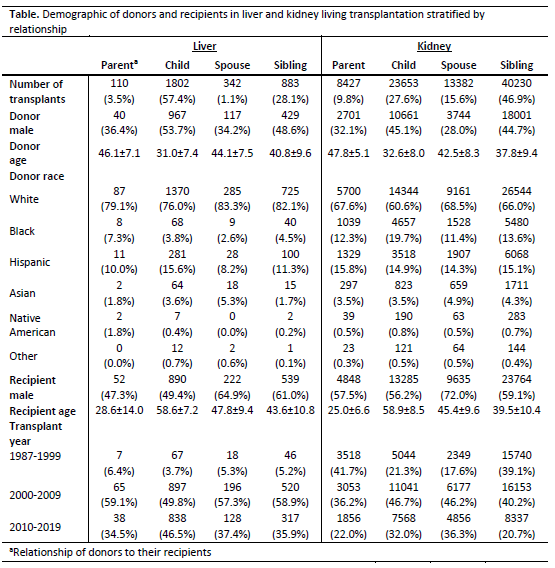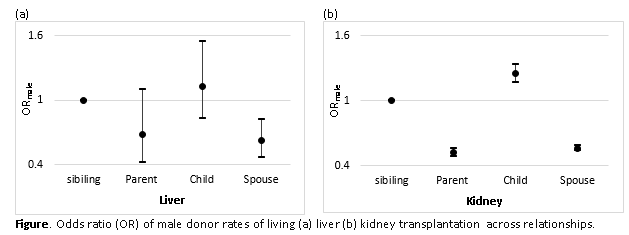Living Donor Gender Disparities Vary by Donor-Recipient Familial Relationship
1Department of Surgery, Massachusetts General Hospital, Boston, MA, 2Department of Surgery, Sinai Hospital of Baltimore, Baltimore, MA, 3Department of Social and Behavioral Sciences, Harvard School of Public Health, Boston, MA
Meeting: 2020 American Transplant Congress
Abstract number: 270
Keywords: Donation, Kidney/liver transplantation, Liver, Living donor
Session Information
Session Name: All Organs: Disparities to Outcome and Access to Healthcare I
Session Type: Oral Abstract Session
Date: Saturday, May 30, 2020
Session Time: 3:15pm-4:45pm
 Presentation Time: 4:27pm-4:39pm
Presentation Time: 4:27pm-4:39pm
Location: Virtual
*Purpose: Women are more likely to be living transplant donors and less likely to be recipients. It has been difficult to distinguish how much of this is due to differences in disease prevalence vs socioeconomic factors. We therefore examined donor gender ratios based on their relationship to the recipient, to help isolate biologic from cultural determinants.
*Methods: Data on living donor liver and kidney transplants 1987-2009 was obtained from the Scientific Registry of Transplant Recipients (SRTR). Our primary outcome was the gender of the donors and the primary exposure was the relationship between donors and recipients. Multivariate logistic regression was performed, adjusting for donor and recipient age, donor race, and recipient gender and height.
*Results: Total of 3,137 adult (donor age: 18-55; recipient age>=18) liver and 85,692 kidney transplantations with family members during 1987-2019 were analyzed in the study (Table). There were more male donors for liver than kidney (61.7% vs 55.7%). For both organs, children had the highest proportion of male donors (53.7% liver, 45.1% kidney), followed by siblings (48.6% liver, 44.7% kidney), then parents (36.4% liver, 32.1% kidney), with the smallest proportion among spouses (43.2% liver, 28.0% kidney) (table 1). After adjusting for demographic factors of the donors and recipients, these differences remained statistically significant in kidney but not liver transplants (Fig 1).
*Conclusions: Donor gender ratios vary by the relationship between donors and recipients. In relationships where the donor and recipient are likely to be in the same household (parents and spouses), the donors are less likely to be the male member of that household, whereas in different households (sibling and child), the donor gender split is more even. Financial constraints may play a role in selecting female rather than male donors, and better economic support for living donors may help alleviate living donor gender disparities.
To cite this abstract in AMA style:
Chen Y, Hung Y, Crescenzo Cde, Rickert C, Hsu Y, Yeh H, Chang D. Living Donor Gender Disparities Vary by Donor-Recipient Familial Relationship [abstract]. Am J Transplant. 2020; 20 (suppl 3). https://atcmeetingabstracts.com/abstract/living-donor-gender-disparities-vary-by-donor-recipient-familial-relationship/. Accessed December 12, 2025.« Back to 2020 American Transplant Congress


